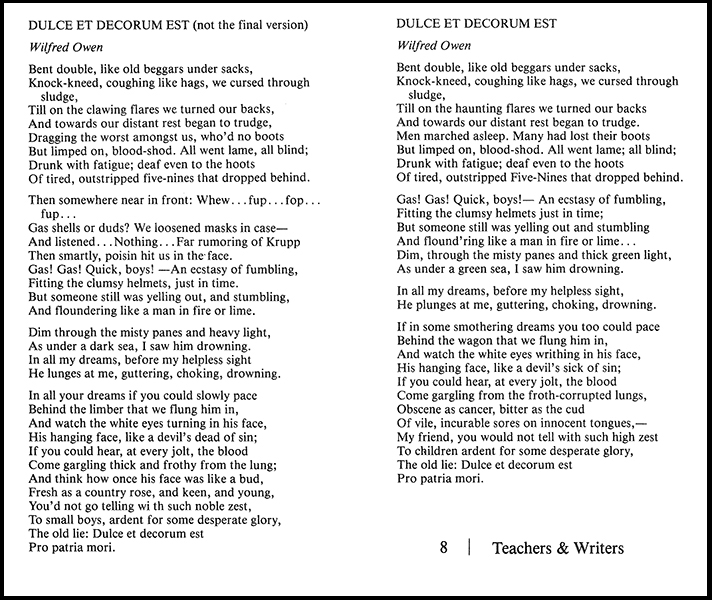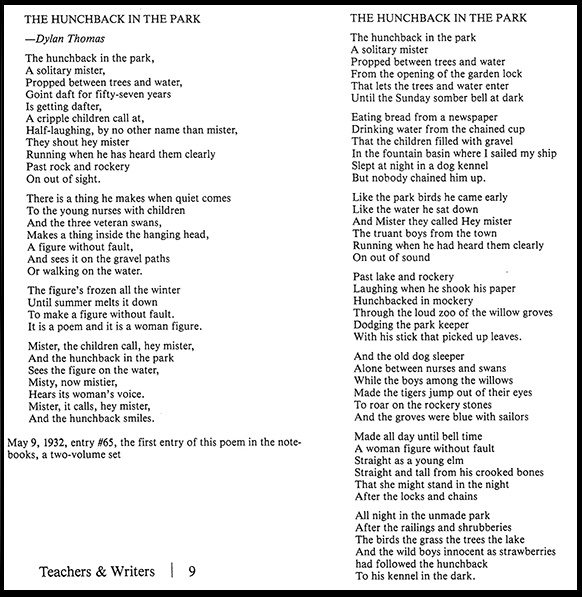Originally published in Teachers & Writers Magazine (1981, Vol. 13, No. 2).
ROUGH DRAFT
What is the shape of a rat?
It is bigger than whatever you’re thinking of.
It is less than a leg
And certainly more than a nose. Just below the surface of the water
It usually travels.Is it nice and soft like a mouse? Can it wiggle its toes?
Can it come in the house
On the tips of its toes?Take the skin of a cat. And the front of an eel,
Roll the two of them together in some grease. That is what it would probably feel like.
It is as sleek as an otter
And it has wide webby toes.
Just under the surface of the water
This is a corruption of an excerpt from “The Lost Son” by Theodore Roethke. It can be used to demonstrate, by contrast, what good poetry is. Students are shown this corrupted version as a poem and asked their opinions. Once they have stated their criticisms and suggestions for improvement, they are shown the actual poem. Some of their criticisms of the corrupted version are likely to be supported by the phrasing choices the poet made. Other parts of the actual poem may reflect principles of good writing the students came to on their own during the initial criticizing. The primary process, however, is the students’ engagement with their own ideas. In their effort to articulate, specify, and support their criticism, they will learn something about poetry, unencumbered by special terminology and analysis of meaning. The sequence of criticizing the corrupted version and then looking at the actual poem is meant to stimulate, however crudely, a poet’s revision work.
This excerpt is short and light, focusing attention on the language. Its strong rhythm and simple rhyme scheme make it particularly good for trying out the exercise. The corrupted version throws this formal unity askew. Some lines have been only slightly changed, whereas others have been grossly distorted, thereby providing obvious examples for criticism. Whatever criticism a student offers, the teacher asks that a passage or line be singled out as an example. Typical comments are “That line isn’t any good,” “I just don’t like that part,” “It’s not clear,” “I think it’s too long,” “The rhythm is all fouled up,” and “It’s boring.”
These criticisms, however offhand, suggest principles of poetry. “It’s too long” suggests that poetry should be concise; “It’s not clear” and “It’s boring” suggest two other principles. If the students like the idea of some principles for focusing their criticism of the poem, they have them in their own comments: poetry should be concise, clear, and interesting.
Students don’t regularly need principles for criticizing, nor are they likely to stop with just stating their opinions. If a student judges a line to be too long, he or she might specify a word or words to cut. This deletion is an act of revision. Likewise, in evaluating a line as boring or unclear, the student may suggest a way to change it. The teacher need only make note of each suggested change, along with lines or parts of the poem that are criticized. The teacher may eventually choose to incorporate all these comments in a revision of the poem, right on the spot. The students are likely to prefer the revision. Even if the revision is not a significant improvement of the corrupted version, the students have been engaged in an activity that begins with their opinions, stimulates ideas for re-writing change, and parallels, in a general way, the poet’s work of revising a poem to its final form.

This poem the students are likely to revise for the better because the most noticeably distorted lines are the ones that trip up the poem’s rhythm. Any suggested improvement of one of these lines will probably help to restore the unifying rhythm. And any change of this sort only makes the other particularly distorted lines all the more obviously inappropriate. So a student’s criticism of a line being too long may come from a recognition of the potential for rhythmic unity. Students are encouraged to grasp this point by the irregular way in which the stanzas have been corrupted. For example, a student criticizing a line in the first stanza may cite the second stanza as the way the rhythm should be.
The teacher might then press for suggestions to bring the other stanzas into line with the second. In the course of this effort, a student may discover the line-ending rhyme of “eel” and “feel” in the third stanza. In turn, they may want to consider how the first and last stanzas might rhyme. Just fooling around with possible rhymes is worthwhile and fun, for the point of the exercise is not to coax the students to every turn of phrase the poet selected, an impossible task in the first place. And what’s worse, the students would pick up on the effort as signaling that the exercise will end with an “answer.” Instead, the students should simply be encouraged to go as far as they can and wish to with their own ideas.
At which point the teacher shows them the actual poem. “This is the poem the poet wrote. You have been working on a rough draft of the poem -but not one the poet wrote. The work you have been doing resembles what a poet does in working a poem to this final form.”
The shape of a rat?
It’s bigger than that.
It’s less than a leg
And more than a nose,
Just under the water
It usually goes.Is it soft like a mouse?
Can it wrinkle its nose?
Could it come in the house
On the tip of its toes?Take the skin of a cat
and the back of an eel,
Then roll them in grease,
That’s the way it would feel.It’s sleek as an otter
With wide webby toes,
Just under the water
It usually goes.
Some students meanwhile are reading the actual poem. They are curious to see what the poet wrote; they are especially curious about lines they criticized. If the line in the real poem goes along with what they thought was wrong with it in the version they studied, they are likely to say so, for their opinion has been confirmed.
It is a good idea to discuss first the lines the students criticized. The poet’s particular phrasing may or may not please the students, but that is not as important as the apparent principle at work in the difference in phrasing. The more the students’ reasons for the changes can be confirmed, the more they can be assured that their thinking coincides with the poet’s approach. This assurance breeds confidence and a sense of sharing.
After discussing the differences in the lines that the students criticized, it is worthwhile to look at the differences in the other lines, and in so doing to consider if any of the differences are for reasons the students have already asserted. For example, if no one pinpointed “Just below the surface of the water” as a line to change, the poet’s line “Just under the water” certainly comes clearly under the heading of brevity. So do other differences. The poet’s phrase “It’s sleek as” is quicker than “It is as sleek as.” Two differences within so few words is more a matter of detailing than subtlety. Similar examples abound and students come to see that conciseness serves the rhythm. This realization is a major insight for it impresses upon the students how constant attention to minute detailing can significantly affect a major dimension of a poem.
No more difficult a realization is the importance of word selection. “Wrinkle its nose,” for example, is more interesting than “wiggle” or “wriggle its nose.” The latter two verbs are predictable, whereas “wrinkle” is surprising without sacrificing any clarity of meaning. Even a change as small as one letter can make a difference: ”On the tip of its toes” is better than “On the tips of its toes” for both sound and image.
Once students have looked at a poem this closely, this will be more sensitive to choices in phrasing. But are there limits to this technique? No, I don’t think so, but there are degrees of effectiveness. Short poems are preferable and it’s a good idea to write the corrupted version line by line. This makes the comparison easier. As much as the rewriting may go against your grain, at least initially, the writing can be fun and you certainly refresh your appreciation of the poem. If you have trouble getting started, use the old paraphrase method that so many of us were instructed to use as a way to ascertain a poem’s meaning. Remember?-a line-by-line prose translation in effect.
The best poems to use are those you find beautiful but hesitate to try to teach because they appear to offer little to discuss. The worst poems to use are those that are too syntactically complex to rewrite line by line. If you find yourself having to rewrite two or three lines at a time, as can happen with Dickinson poems, simply choose another poem.
You may find that this technique works best for you with poetry that is metered and rhymed, but to show you that a poem’s form is not necessarily a limitation to this technique, I would like to take on, as an example, a considerably harder poem, harder because the poem is ”prosy” and depends almost entirely on the quality of the language and choice of detail.

“A Blessing” by James Wright is a sentimental poem. Meddling with the lines might make it irretrievably corny. On the other hand, minimizing the corruption of the poem could leave little for the students to criticize, other than the actual poem. So isn’t there a danger that the exercise will either backfire or fizzle?
There is always that danger with any technique-with any approach to teaching for that matter-which does not minimize the difficulty of using this poem for this exercise. Nevertheless, the argument against it is pertinent to only the first stage of the process, the criticizing of the corrupted version. The heart of the process is, however, the comparison of the corrupted and the real poem. At what point in the process students make their discoveries of the nature of poetry is not important. What is, is the clarity and impact of their insights.
Let me try to prove this claim. Here is a corrupted version of “A Blessing” by James Wright.
Just off the highway
Twilight falls softly on the grass.
And the eyes of those two Indian ponies
Grow darker and are kind.
They seem to have come gladly out of the willows
To welcome us.
We stride into the pasture
Where they appear to have been grazing all day.
They wiggle, for they can barely hold in their happiness.
That we have arrived.
They bow shyly as wet birds. They seem to love each other.
I don’t think there is a loneliness quite like theirs.
At ease again
They begin munching the spring grass in the dark.
I want to hold the slenderer pony,
For she has come over to me
And nuzzled my hand.
Her mane falls all over her forehead,
And the breeze makes me want to pat her ear
That is as delicate as the wrist of a young girl.
All at once I understand
That if I would step out of my body I might begin
To blossom.
If the students have already sharpened their sensitivity on a couple of easier poems, they are likely, I believe, to spot such tentative verbs as “seem,” “appear,” and “think,” but let’s assume, in order to put the technique in question, that nothing of what the students criticize or suggest speaks to the lovely poem buried in this corruption. Incidentally, this is not a failure, neither on the students’ nor teacher’s part. Here is the actual poem:
Just off the highway to Rochester, Minnesota,
Twilight bounds softly forth on the grass
And the eyes of those two Indian ponies
Darken with kindness.
They have come gladly out of the willows
To welcome my friend and me.
We step over the barbed wire into the pasture
Where they have been grazing all day, alone.
They ripple tensely, they can hardly contain their happiness
That we have come.
They bow shyly as wet swans. They love each other.
There is no loneliness like theirs.
At home once more,
They begin munching the young tufts of spring in the
darkness.
I would like to hold the slenderer one in my arms,
For she has walked over to me
And nuzzled my left hand.
She is blackened white.
Her mane falls wild on her forehead,
And the light breeze moves me to caress her long ear
That is delicate as the skin over a girl’s wrist.
Suddenly I realize
That if I stepped out of my body I would break
Into blossom.
Helpful to this exercise is having on hand some rough drafts actually written by the poets. Using one in place of a corrupted version can have considerable impact on the students, especially if they are not so informed until after they have completed the exercise. Telling them beforehand is a good idea if they have expressed any interest in whether or not what they have been doing, in fact, resembles what a poet does in writing a poem.
Were there rough drafts available for all the poems we would like to teach, there would be little point to this technique. However, poets reveal their worksheets begrudgingly, if at all. Two rough drafts I like to use with the completed poems are Wilfred Owen’s “Dulce Et Decorum Est” and Dylan Thomas’s “The Hunchback in the Park.” I like these two examples for their contrast: the Owen draft is a late one and the Thomas draft the very first one. Thus, the Owen comparison of the draft and finished poem demonstrates the fine tuning a poet strives for in the completion of a poem, whereas the Thomas comparison demonstrates how a meager first draft can be transformed into a memorable poem.


Peter Sears is the author of I Want to Be a Crowd (Breitenbush Publishing Co.), an introductory poetry book. He has taught creative writing at Reed College and at Bard College where he worked with Peter Elbow.



